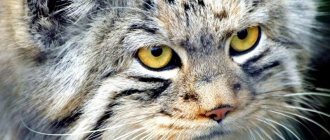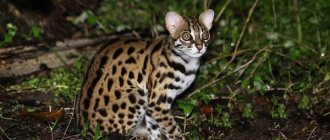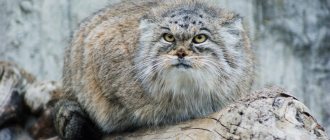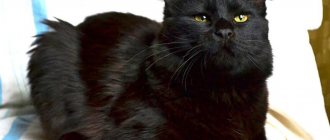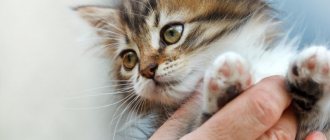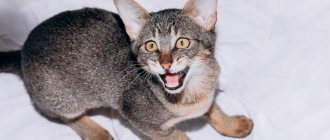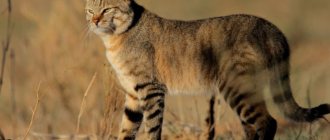01 March80028wild catsmanulpredatorPallas cat
The wild cat Manul is a predatory representative of small cats from the Felidae family. Manul is an interesting and unusual animal. The manul cat is smart, careful and secretive. The Pallas cat is also called the Pallas cat. In this article you will find a description of the Pallas's cat and its photo, and you can also learn a lot of interesting things about the amazing animal with the mysterious name Pallas's cat.
Description and origin of the species
The first scientific description of the animal was given by the German naturalist Peter Simon Pallas in 1776. He met the animal while traveling in eastern Siberia, and gave the cat its first scientific name Felis manul.
In 1842, Johann-Friedrich von Brandt, a German naturalist working in Russia, proposed placing the animal in a separate genus of Pallas' cat (
Otocolobus
).
Later in 1907, the British zoologist Reginald Innes Poukok finally approved the classification: the animal is the only representative of the monotypic genus of Pallas's cats, and bears the scientific name Otocolobus manul.
The name manul is borrowed from the Kyrgyz language, and translated means “cat” in Kyrgyz. In Mongolian the word sounds a little different, “manol”. The name Pallas' cat was first proposed by the English zoologist William Blanford. Latin genus name Otocolobus
comes from ancient Greek, and literally means dwarf ear.
The closest relative of the animal is the genus Eastern cats (Prionailurus). It includes small predators of the cat family that live exclusively in Asia - the Bengal cat, the Sumatran cat, the fishing cat and the spotted cat. According to mitochondrial DNA analysis, the ancestors of Pallas's cat separated from a common ancestor with eastern cats from 9.4 to 1.46 million years ago.
No fixed abode
Bye bye! /Photo: pikabu.monster.
Pallas' cats constantly change their place of residence, although during their migration from place to place, "Otocolobus manul" from time to time settles in the most unpredictable places for sleep and rest. Most often, Pallas' cat nests between stones. Less often, they may choose the shelter of some smaller animal, which the cat had previously turned into saving calories during the hunt.
What does a manul look like - size and appearance
Pallas's cat is comparable in size to domestic cats. The body length of the animal is from 46 to 65 cm, the tail length is from 21 to 31 cm. The weight of the cat is on average from 2.5 to 4.5 kg. The animal has a stocky build, short legs and thick long fur, so in appearance the cat seems denser and more massive than it actually is. Pallas's cat has the thickest fur of all cats - there are up to 9,000 hairs per square centimeter, each up to 9 cm long.
The color of the animal varies from light gray to dark yellow, with vertical dark stripes on the body and front legs. In winter, the fur is grayer, and with less pronounced stripes, than in summer. at the ends the hair is painted white, which gives the skin a snow-dusted appearance. Dark rings are clearly visible on the tail, and dark spots on the forehead. On the cheeks, horizontal dark stripes extend from the corners of the eyes to the side. Dark and white circles around the eyes emphasize their round shape. There is light fur on the chin and throat, which smoothly blends into light gray on the belly.
Pallas' cat's paws are proportionally the shortest among all cats. The ears are very small, and low set and fairly wide apart. The muzzle is noticeably shorter than that of other cats, so it seems that the animal is looking from under its brows. Due to its short jaw, the cat has fewer teeth than other wild cats, but has long fangs. The animal has short claws, and unusual round pupils, compared to other felines.
Is it possible to keep him at home?
Unlike its relatives, the Pallas's cat cannot be domesticated due to its indomitable nature. It is believed that if any animal is taken home when it is still a small kitten, it can grow up tame, with behavior no different from a domestic cat. But this is not about the manula. There are no guarantees that it will take root. Even if he is raised by a domestic cat along with his kittens, the manul will not be able to love them, and when he grows up, he will be aloof both from his half-sisters and brothers, and from people whom he has known since childhood. You need to know about this in advance before the manul appears within the walls of the house in order to make a decision for yourself whether such a wayward pet will suit you.
Character and lifestyle
Manul, like other wild cats, leads a solitary and sedentary lifestyle. Each animal has its own territory, which they mark with scent marks. The size of its own range varies depending on the habitat and food supply, but no more than 10 square kilometers per predator.
During the day, animals rest in caves, rocky outcrops, former dens of marmots and foxes, and at dawn and in the late afternoon they go hunting. Cats hunt prey from ambush, or sneak up unnoticed, using stones and bushes for cover. The color of the animal perfectly camouflages it among the snow and stones.
Pallas cats are the most clumsy and slow of all wild cats. They are not adapted to running, and chase prey, relying solely on surprise attacks from ambush. In case of danger, they hide, camouflage themselves against the background of stones, and climb onto the rocks.
Where does the manul live?
Pallas's cat lives in the steppes of Central Asia. It can be found in the following countries:
- Kazakhstan
- Tajikistan
- Kyrgyzstan
- Iran
- Afghanistan
- Pakistan
- Nepal
- India
- Butane
- Mongolia
- China
- Russia
In Russia, the Pallas's cat lives in the Trans-Baikal Territory, Chita, Altai, the Republic of Tyva and Buryatia. The animal is found in western China. Previously, Pallas's cat also lived in Armenia and Azerbaijan (in 2017 it was seen in the Zangezur National Park of Azerbaijan), but according to data for 2022, the populations in these countries have been almost completely exterminated.
As a habitat, the Pallas's cat prefers open steppe spaces with low snow cover in winter and a sharply continental climate. It is found in the highlands at an altitude of up to 4,000 meters above sea level - in rocky crevices, rocky outcrops, semi-desert areas of mountains and bush thickets. Practically does not live in forests and lowlands.
Owner reviews
Ilya, 30 years old: “Actually, I didn’t intend to have any animals. Pal's cat was given away by friends and they were leaving. I thought it would be worse. But there are no particular problems with him. I live in a private house, there is a large yard, and the cat hangs out there all the time. He rarely comes home, eats and then comes back. Doesn't bite, doesn't scratch, can snort if he doesn't like something. And he doesn’t like my dog, but they hardly intersect.”
Maria, 25 years old: “Once, my husband and I did a noble deed: we saved an animal from a poacher. Later they found out that it was a Pallas's cat. He lived with us for a couple of months, ruined all the furniture, and scared the child. They gave it away at the first opportunity.”
Oksana, 32 years old: “I have long dreamed of a Pallas’s cat. I love cats, but I don’t have time to cuddle and play with them. I took a little cat, he was quite calm. Then she grew up (it was a cat) and began to demand a cat. I couldn’t find a mate, and my favorite’s character had completely deteriorated. She became angry, scratched and bit, the vet said it was a hormonal imbalance. I had to give it to the zoo, it’s a shame.”
What does manul eat?
Pallas's cat feeds mainly on pikas, small birds (Asian mountain partridge), and mice (clawed gerbil, vole). The pika is a small animal belonging to the lagomorphs, the size of a hamster. Less commonly, Pallas's cat hunts tolai hares, gophers and young marmots. In the summer, when there are few pikas, the cat actively eats insects - grasshoppers, locusts, etc.
Reproduction and young
The mating season for Pallas cats is very short due to the harsh climate in its habitat. Estrus lasts only 26 to 42 hours, which is much shorter than that of other wild cats. Pregnancy lasts from 66 to 75 days, the female usually gives birth in April or May. In a litter, from 2 to 6 kittens are born. Kitten survival rate is quite low (44% of kittens die before 30 days of age), so large litters compensate for high mortality and harsh climate conditions.
Females give birth in a den lined with dry grass, feathers and wool. Crevices, small caves, and old holes of marmots, badgers, and foxes are used as dens. Kittens are born weighing only about 90 grams, blind and helpless, covered with thick fluffy fur, which is replaced by full adult fur at the age of 2 months. From 4 months, the cubs begin to hunt, at 6 months they reach the size of an adult cat and begin an independent life. Puberty in Pallas' cats occurs after 10 months.
Natural enemies and threats
Pallas's cat is often hunted by wolves and eagle owls. In addition, at a young age the animal is very susceptible to infectious diseases. A serious threat to the animal is snowy winters and prolonged ice, as well as a reduction in food supply - a decrease in the population of rodents, pikas and other prey.
Human actions currently pose a significant threat to the species:
- poachers kill animals for their skins in Mongolia, China and Russia;
- wild cats regularly fall into snares set for marmots and hares, and traps for wolves and foxes;
- animals are often killed by herding and domestic dogs.
Population and conservation of the species
It is difficult to calculate the exact number of animals due to the inaccessibility of their habitat and excellent camouflage, but the number of cats is declining everywhere. According to data at the beginning of the 2000s, there were from 3,000 to 3,650 Far Eastern individuals left in Russia, most of them were in the Chita region.
The wild cat is listed as a “species of least concern” by the IUCN Red List and is included in the Russian Red Book. Hunting for Pallas's cat is prohibited in all countries of its habitat except Mongolia.
Since 2013, the Far Eastern Pallas's cat has been studied in the Daursky National Nature Reserve as part of the Russian Geographical Society's program for the conservation of Pallas's cat in Transbaikalia. The main goals of the program are to study the animal's natural habitats and migrations, as well as measure the survival rates of kittens and adults.
As of 2010, there were 47 individuals kept in zoos around the world. Pallas' cat breeds well in captivity, but they are highly susceptible to disease due to an underdeveloped immune system. In the wild, animals' habitat is limited, and outside of it, animals suffer from viruses that are not found in their natural environment of the highlands and steppes.
Diet
At night, the predator goes out hunting, slowly making its way through tall grass or sparse bushes. The cat makes sounds extremely rarely.
Manul prefers not to go far from his lair, so seeing him near human settlements is almost impossible. Pallas's cat will never be left without prey; his hunting skills are at a high level.
The main victims of the predator are small rodents. In addition to mice, gophers, pikas, he will not refuse to catch a hare, a marmot or even a small bird. However, in times of hunger the animal does not disdain even insects.
The approximate diet of the Transbaikal Manul under natural conditions consists of more than half of Daurian pikas, 1/5 of the daily volume it eats bugs, and about 10% of the prey consists of pigeons, swifts, partridges, bluetails, and quails. The remainder comes from ground squirrels, jerboas, hamsters, voles, berries and plants.
Manulas at home
Many people, seeing the unusual appearance of the animal, want to keep it at home. Yes, in size and appearance it really resembles a domestic cat, but the Pallas's cat is a wild animal, and will remain so even if you adopt a kitten. It will not be possible to tame it even after keeping it at home for a long time.
Keeping a Pallas's cat at home, in addition to its wild nature, will be associated with other difficulties:
- animals do not eat unfamiliar food
- animals often get sick and are susceptible to viruses, since their immune systems are adapted only to their limited habitat
- The animal's long and thick fur will not allow it to be kept at home; it will be too hot.
Behavior
Although experts believe they appeared about five million years ago, very little is known about them.
Pallas's cat is a solitary nocturnal animal, although it can be active at dusk and early in the morning. During the day he sleeps in rock crevices and small caves. They often live in the burrows of other small animals such as marmots, foxes and badgers. Scientists have noted their extraordinary ability to hide in their own habitat. Their markings and colors allow them to easily blend into their surroundings.
The Pallas' cat has been observed to be a very poor runner and will instead seek refuge on boulders or small crevices when pursued. Few of these animals are kept in captivity, but those that are are usually aggressive and fearless towards people. He usually doesn't spit or hiss when approached, but when excited he squeals and growls. This sound is more like the barking of a small dog than the meowing of a domestic cat. They have also been observed to purr like house cats.
The main behavior is nocturnal mobility - solitary.
